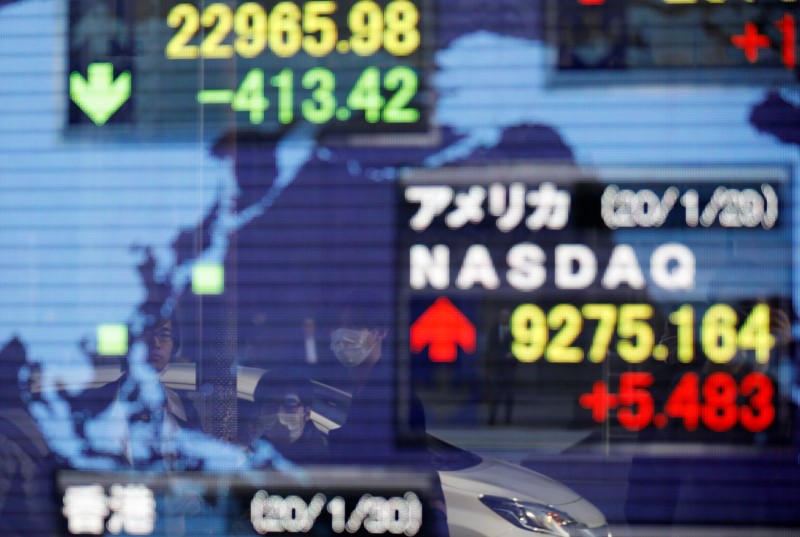By Tom Westbrook
SINGAPORE (Reuters) - The dollar surged and everything else was blown away on Thursday as emergency central bank measures in Europe, Japan, the United States and Australia failed to halt a fresh wave of panic selling.
"There's no buyers, there's not much liquidity and everyone is just getting out," said Chris Weston, head of research at Melbourne brokerage Pepperstone.
Stocks, bonds, gold and commodities fell as the world struggles to contain coronavirus and investors and businesses scramble for hard cash.
U.S. stock futures
The growth-sensitive Australian dollar was crushed 3% to a 17-year low and has fallen more than 20% this year.
Nearly every stock market in Asia was down and circuit breakers were hit in Seoul, Jakarta and Manila.
"We are clearly living in extraordinary and challenging times," said Reserve Bank of Australia Governor Philip Lowe in a speech broadcast across the country.
"I am not able to provide you with an updated set of economic forecasts. The situation is just too fluid," he added.
MSCI's broadest index of Asia-Pacific shares outside Japan (MIAPJ0000PUS) fell about 5% to a four-year low, with Korea and Taiwan leading losses.
Traders reported huge strains in bond markets as distressed funds sold any liquid asset to cover losses in stocks and redemptions from investors.
After the sharpest three-day selloff in Australian 10-year bonds since 1987, the long end of the curve was a smoking ruin.
Benchmark 10-year sovereign bond yields in New Zealand, Malaysia, Korea and Singapore and Thailand also surged as prices tumbled, while U.S. 10 year Treasuries (US10YT=RR) rose 10 basis points through the session.
Gold
The Nikkei (N225) fell 1%, the ASX 200 (AXJO) dropped nearly 4%, while the Kospi (KS11) lost 8% and the Hang Seng 3%.
"We're in this phase where investors are just looking to liquidate their positions," said Prashant Newnaha, senior interest rate strategist at TD Securities in Singapore.
SELL EVERYTHING
The selloff followed an attempt at stabilizing in morning trade, with an ECB pledge to buy 750 billion euro ($820 billion) in bonds through 2020 offering some support.
In the afternoon the U.S. Federal Reserve promised a liquidity facility for money market mutual funds, while the Bank of Japan made two unscheduled bond purchases totaling 1.3 trillion yen ($12 billion).
The Reserve Bank of Australia also cut interest rates to a record-low 0.25% and announced an historic foray into quantitative easing.
But as with previous massive stimulus measures already announced by central banks around the world, it offered little salve to dire sentiment.
"I'd say the market is uninvestable at this point," said Daniel Cuthbertson, managing director at Value Point Asset Management in Sydney. "Until we get a containment of global contractions, the market is just going to be directionless."
In currencies, everything except the dollar and the euro collapsed. Sterling
The Korean won
The New Zealand and Australian dollars were down more than 4% at one point, before recouping some of the losses.
Oil steadied after an overnight plunge to an 18-year low in Asian trade, with U.S. crude (CLc1) last up 12% to $22.77 and Brent (LCOc1) up $1.15 to $26.03.
LOCKDOWNS LOOM
Meanwhile, the virus outbreak has worsened and traders talk of possible lockdowns in the world's financial capitals.
Australia and New Zealand shut borders to foreigners and non-residents on Thursday to try and halt the spread.
Italy on Wednesday reported the largest single-day death toll increase from coronavirus since the outbreak began in China in late 2019.
It has killed almost 9,000 people globally, infected more than 218,000 and prompted emergency lockdowns on a scale not seen in living memory.
J.P. Morgan economists forecast the U.S. economy to shrink 14% in the next quarter, and the Chinese economy to drop more than 40% on an annualized basis in the current one, one of the most dire calls yet as to the scale of the fallout.

"There is no longer doubt that the longest global expansion on record will end this quarter," they said in a note. "The key outlook issue now is gauging the depth and the duration of the 2020 recession."
